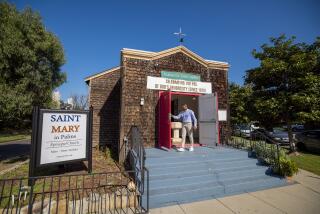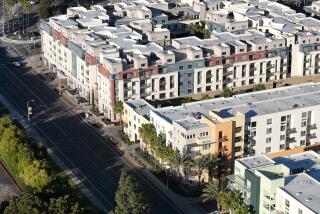Volunteers Build Homes for Poor : Habitat for Humanity Helps Construct Low-Cost Homes for Needy Families
Last winter, David Avila, a janitor at a McDonald’s restaurant, his wife, Maria, and their five children were living in a tiny shack in Riverside.
The place was so cramped that some of the children slept in parked cars. There was one lamp for light and a bare concrete floor. The family used an outhouse for showers and toilets.
But those hardships are over for the Avila family.
In April, the Avilas moved into a newly built four-bedroom, two-bath home with a yard bordered with rose bushes that Maria planted. The house has a ramp and extra-wide doorways for the eldest son, Jorge, who is a quadriplegic.
While modest by most standards, the peach-colored stucco house in a run-down Riverside neighborhood is something of a miracle: new housing affordable to a poor family in an era of spiraling real estate inflation when many middle-income families can’t buy houses.
The house was built by Habitat for Humanity, a volunteer organization dedicated to housing the poor and homeless. The organization started 14 years ago in rural Georgia, but only recently has caught fire on the West Coast.
The Avila house is the first built by Habitat for Humanity in Southern California. More are planned, and Habitat chapters are springing up throughout the Southland, as well as in the San Francisco Bay area, where one chapter is helping to build housing for victims of last October’s earthquake.
As a result of Habitat’s efforts in Riverside, the Avilas, who could not afford to rent a decent apartment, are now proud homeowners. They put up $500 as a down payment and agreed to make monthly payments of $350, which covers the mortgage, insurance and taxes.
Getting the Avilas into a house of their own was not easy. It took more than $40,000 worth of donated construction materials and labor, all of it coordinated and overseen by Habitat.
The lot was purchased for $15,000, using grants from foundations and a city block grant.
Then came many weekends of work donated by professional plumbers, electricians and carpenters, as well as by novices who, under professional supervision, helped in pouring concrete, framing and performing a multitude of other tasks.
The Riverside Area Board of Realtors swooped in one weekend to do the landscaping.
Habitat has set the price of the home at $50,000, which is probably half its true market value, and in 20 years, it will be paid for.
The founder of Habitat for Humanity, Millard Fuller, was a self-made millionaire in Montgomery, Ala., who reached a crisis in his life 20 years ago that he says inspired him to give away everything he owned--including a lake cabin and 2,000 acres of land--and dedicate himself to Christian service.
“Habitat is an unashamedly Christian organization, and we are challenging people to help solve the poverty, housing and homeless problems out of a religious motivation,” Fuller said in a telephone interview from his home in Georgia.
Fuller said that after helping to build houses for poor Southern blacks and for villagers in Zaire, Africa, he realized that he had a concept that might have worldwide application.
The concept, he said, was to use private funds and volunteer labor to build basic houses, and then to sell them to poor families at no profit on no-interest mortgages.
Money collected from the home purchasers over the life of 15- to 25-year mortgages is recycled into more projects.
Fundamental to the Habitat philosophy is a requirement for the poor who are being helped to work in building their houses. They are required to invest 500 to 1,000 hours of “sweat equity” in home building and other community service.
Habitat officials stress that they are building houses for the working poor, not for derelicts or people in search of handouts.
There are scores of applicants for each house, and the criteria for selection includes both neediness and a commendable employment and credit history. A family’s religious affiliation, or lack of it, is not a factor in deciding who gets a house, Fuller said.
The Habitat movement began in Americus, Ga., in 1976, Fuller said, “and by 1980, we were building homes in 11 cities in the United States and three countries.”
Habitat got a big public relations boost in 1984 when it attracted the support of former President Jimmy Carter, who works on Habitat projects every summer.
To raise public awareness of the need for low-income housing, Habitat has capitalized on Carter’s involvement and the excitement of what it calls “blitz” housing construction.
Each June, Habitat stages a “House Raising Week,” during which a large number of houses are built from scratch by volunteers in a “barn-raising” atmosphere.
During this week Habitat plans to build between 600 and 700 houses throughout the United States and overseas, Fuller said.
Also, during House Raising Week, Habitat organizes a “Jimmy Carter Work Camp,” where Carter and his wife, Rosalynn, join in the marathon home building.
This June, the Carters will be among an estimated 2,000 volunteers who will build 100 houses in Tijuana and seven in San Diego--in one week.
The director of the San Diego Habitat chapter, Ken Sauder, said he has been preparing for the work camp for the last six months.
“We have been getting land and building approvals and commitments from contractors and individuals to give us materials,” he said. When the week begins, he said, the foundations for the homes will have been poured and all materials stacked on site.
In Tijuana, the volunteers, who come from around the country as well as from Habitat projects overseas, will sleep on cots in a “tent city,” Sauder said, and will eat food donated by local restaurants and hotels and prepared by churches.
Sauder, 35, who has a master’s degree in city planning from the University of Pennsylvania, has chosen to work for modest wages as a Habitat organizer because he loves what he is doing.
“What is unique about Habitat,” he said, “is that it has taken a very complex problem and breaks it into tasks that average people can get involved in solving.”
According to Habitat, it has 454 affiliated organizations in the United States, six in Canada, three in Australia and one in South Africa. In addition, it has more than 70 projects in 26 developing countries.
Fuller estimates that Habitat has built or rehabilitated 6,000 homes--which he acknowledges hardly makes a dent in alleviating the worldwide housing needs of the poor.
But that doesn’t mean the problem can’t be solved, Fuller said. “One of the devil’s neatest tricks is to convince people that something can’t be done,” he said.
Fuller said that now that Habitat’s organizational structure has matured, housing production is gaining momentum.
This year alone, he said, Habitat will build 4,300 homes, and next year that number will expand to 6,000. By 1994, he said, he expects to be building 10,000 houses a year.
A obstacle to Habitat’s efforts at building new houses in Southern California has been the high price of land, a problem compounded by low-density zoning and costly development fees imposed by local governments, Habitat organizers said.
Eddie Wedin, a retired nurse who is executive director of the Habitat chapter in Ventura, said that chapter is the oldest in California, having started in 1982.
But so far, she said, the Habitat chapter in Ventura has been forced to confine its efforts to home remodeling because it has been unable to find affordable land or obtain the cooperation of city governments.
“We dream of building houses,” she said. “When you see how fast things have developed in Orange County, you have hope.”
In Orange County, a 3-year-old Habitat chapter is in the process of building three townhouses in Santa Ana and two in Anaheim. Both projects are being built on land made available by the cities. In Santa Ana, Habitat received 60 applications for the three townhouses.
“It’s like winning the lottery for me,” said Irma Garcia, 34, whose family was selected. Garcia is a single mother whose five children sleep on the living room floor of a shared apartment.
Garcia, who works as a computer-component assembler at a plant in Irvine and pays $225 a month rent, said she is looking forward to having closets. Now, she said, all of the family’s clothes are kept in boxes.
But by far the most ambitious Habitat endeavor in Orange County--and the single largest in the country--is a project under way to build 48 condominiums for the working poor on two acres of donated land in Rancho Santa Margarita.
To make the project economically feasible, the Fieldstone Co., a Newport Beach-based home builder that is building in Rancho Santa Margarita, entered a joint venture with the master developer of the community, the Santa Margarita Co.
Fieldstone was able to donate the site to Habitat because the Santa Margarita Co. agreed to allow Fieldstone to build more houses on other parcels that Fieldstone owns in the project, said David Langlois, a Fieldstone vice president in charge of the Habitat project.
Because the total number of houses built in Rancho Santa Margarita could not be increased because of government density restrictions, the Santa Margarita Co. in effect donated to the Habitat project some of the development--and thus some of the profits--that it otherwise would have gained in the rest of the project.
Fieldstone agreed to pay for the lot improvements and function as general contractor for the Habitat project. Fieldstone will coordinate the volunteer labor, which it has solicited from its own subcontractors with enthusiastic response.
Ground breaking is scheduled Wednesday.
Mary Hendrickson, manager of charitable contributions for Fieldstone, said the Habitat concept “sounded like a perfect fit for us. What we do best is building houses, and what they do best is help the working homeless.”
Langlois said the Habitat homes will appear on the outside identical to the other “early-California-style” condominiums Fieldstone is constructing nearby.
Inside, however, they will be simpler, without fireplaces and microwaves and decorated with a lower grade of carpet and plumbing fixtures.
Langlois figures that if Habitat is going to make any meaningful headway in Southern California, “it will have to overcome the high price of land and political opposition, and will have to build at high density.”
To do this, he said, the movement needs the skill and experience of professional builders.
“We would like to inspire other builders to catch the vision,” he said.
MORE ON HABITAT FOR HUMANITY More information on Habitat for Humanity, volunteering or applying for a home may be obtained from the regional or affiliate offices.
* Regional office, (714) 647-4904.
* Riverside, (714) 787-6754.
* Tijuana/San Diego, Ken Sauder, (619) 233-7551.
* Orange County, (714) 639-5557.
* Ventura, (805) 648-4646.
* Coachella Valley, Clarence Spier, (619) 347-1502.
* Pasadena, Ace Cain, (818) 790-1391.
* Lake Elsinor/Temecula, Kim Quon, (714) 674-0543.
More to Read
Sign up for Essential California
The most important California stories and recommendations in your inbox every morning.
You may occasionally receive promotional content from the Los Angeles Times.










